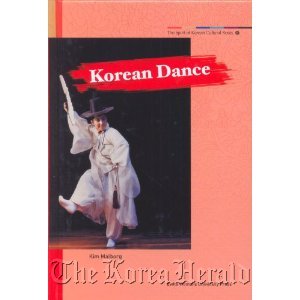
By Kim Malborg
Translated by Lee Jean-young
(Ewha Womans University Press)
Although local ballet troupes have developed their original Korean repertoires ― such as “Shim Chung” and “Prince Hodong”― and received enthusiastic reviews overseas, little is known about traditional Korean dance in the international dance scene.
For those who are interested in exploring the world of Korea’s traditional dance, local scholar Kim Malborg’s English-translated book, “Korean Dance” is a useful guide. It introduces the long history of Korean dance, including court dance, folk dance and ritual dance.
“The root of Korean dance is closely related to our everyday lives,” writes Kim in the book. “It was a collective act that took place at work, during rituals and ceremonies, and during festivities as a way to express the deepest desires of the human heart. Dance was closely integrated into all areas that formed the basic way of life for our ancestors ― such as farming, repose, religion and artistic activities.”
Throughout the book, Kim chronicles how dance evolved throughout Korea’s three kingdom period (B.C. 37 ― A.D. 668) to the Unified Silla (668-935) Goryeo (918-1392) all the way to the Joseon Dynasty (1392-1897). According to Kim, the dances of Silla were unique, bold, elaborate and artistic, with rich theatrical elements and fascinating storylines. The dances told the stories of mythical heroes and deities, and were choreographed to imitate how the characters act in their imaginations.
Chinese court and ritual dances were imported during the Goryeo Dynasty, while many Buddhist dance moves and festivities were developed.
“Along with Chinese instruments, music, dance and court rituals, Chinese court dances were also introduced and performed in royal banquets alongside Korean traditional dances,” writes Kim.
In the Joseon period, Korean dance underwent a lot of changes as Confucianism took a major role in the state. The noble class refrained from dancing, and collective festive activities disappeared as a result. In the latter half of the Joseon period, Seumgmu (Monk Dance) and Salpuri (Spirit-Cleansing Dance) were created by entertainers who belonged to the lowest caste of Joseon.
It was in 1908 that the first national western style theater, “Wongaksa” was established in Korea.
“From this time, Korean traditional court dances and folk dances were performed on western style stages,” Kim writes. “The early performers were the gisaengs belonging either to the royal court or private gisaeng houses. Their repertoire did not consist of dance alone but was rather a mixture of dance and singing.”
Kim Malborg received her bachelor’s and master’s degrees in dance from Ewha Womans University, and her Ph.D. from the University of Wisconsin-Madison in the U.S. She currently teaches at Ewha Womans University and serves as the president of Korean Society for Dance Studies. Her previous publications include “Understanding Dance” (2003) and “Dance Art and Theory” (1987).
(dyc@heraldcorp.com)



![[Weekender] Pet food makers bet big on ‘recession-free’ pet food market](http://res.heraldm.com/phpwas/restmb_idxmake.php?idx=644&simg=/content/image/2024/05/10/20240510050754_0.jpg&u=20240512145510)


![[Drama Tour] Romantic trip to ‘Queen of Tears’ filming spots](http://res.heraldm.com/phpwas/restmb_idxmake.php?idx=644&simg=/content/image/2024/05/09/20240509050798_0.jpg&u=20240511190213)











